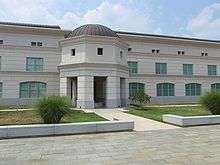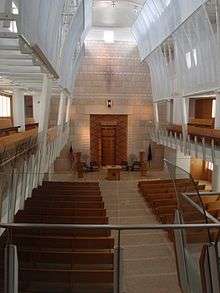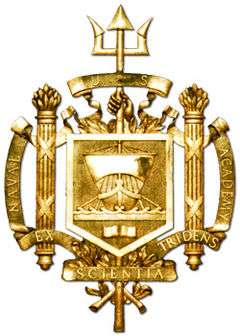Naval Academy Jewish Chapel
| Commodore Uriah P. Levy Center and Jewish Chapel | |
|---|---|
 Commodore Uriah P. Levy Center and Jewish Chapel | |
 Location within Maryland | |
| Basic information | |
| Location | Annapolis, Maryland |
| Geographic coordinates | 38°58′49″N 76°28′52″W / 38.980278°N 76.481189°WCoordinates: 38°58′49″N 76°28′52″W / 38.980278°N 76.481189°W |
| Affiliation | Judaism |
| Status | Active |
| Architectural description | |
| Architect(s) | Joseph Boggs[1][2] |
| Architectural type | Synagogue |
| Groundbreaking | November 2, 2003[2] |
| Completed | 2005 |
| Interior area | 35,000 square feet (3,300 m2)[1][2] |
Commodore Uriah P. Levy Center and Jewish Chapel is the Jewish chapel at the United States Naval Academy, in Annapolis, Maryland.
The center is named in honor of Commodore Uriah P. Levy (1792–-1862), the first Jewish commodore in the United States Navy, who is famous for refusing to flog his sailors.[3][2] The Levy Center is adjacent to Mitscher Hall and contains a 410-seat synagogue, a fellowship hall, a Character Learning Center, classrooms, and offices for the Brigade’s social director, the academic board, and the Academy’s Honor Board.[2]
Before the chapel was completed in 2005, Jewish midshipmen attended Congregation Knesset Israel in downtown Annapolis,[4] or held services in the interfaith chapel at Mitscher Hall.
History
The groundbreaking ceremony was held on November 2, 2003.[2] The builder was the Whiting-Turner Contracting Company.[2] The building was dedicated in September 2005.[5]
The Levy Center cost $8 million to design, build and furnish.[2] Approximately $1.8 million was paid for with military construction funds.[2] The remaining amount was paid for by private donations raised by the Friend of the Jewish Chapel, a campaign headed by Jewish alumni of the academy and others.[2][1] It was given to the Academy upon completion.[1]

Architecture
The 35,000-square-foot (3,300 m2) building was designed by Maryland architect Joseph Boggs.[1][2] The entrance pavilion has elements related to the center bay of Thomas Jefferson's Monticello. Levy purchased Monticello in 1834 and restored it because of his admiration for Jefferson, who died in 1826.[6] The chapel includes a nearly 45-foot-high wall that is a replica of the Western Wall in Jerusalem. The wall is made of Jerusalem stone.[4] The roof of the building is constructed of copper.[2] The architecture of the exterior is consistent with nearby Bancroft Hall.[7]
The chapel was awarded the Maryland AIA Honor Awards 2006, Public Building of the Year; Institutional.[8]
See also
- Aloha Jewish Chapel
- West Point Jewish Chapel
- Jewish American military history
- National Museum of American Jewish Military History
- Jewish War Veterans
- Naval Academy Chapel
- United States Navy Chaplain Corps
- United States Air Force Academy Cadet Chapel (including Jewish chapel)
- United States Military Academy Chapel
Footnotes
- 1 2 3 4 5 Lebovich, William (May 3, 2006). "Navy Temple". Architecture Week. p. D1.1. Retrieved 2010-03-18.
- 1 2 3 4 5 6 7 8 9 10 11 12 Facts: The Commodore Uriah P. Levy Center and Jewish Chapel. Public Affairs Office. U.S. Naval Academy official website. Retrieved 2010-03-18.
- ↑ Bailey, Steve (August 22, 2008). "In Annapolis, Md., the Past Is Always at Hand". New York Times. Retrieved 2010-03-18.
- 1 2 Harris, Hamil R. (September 17, 2005). "Jewish Chapel Is Set to Open at Naval Academy". Washington Post. p. B09. Retrieved 2010-03-18. The link includes a photo of the chapel interior.
- ↑ "Press Kit: Uriah P. Levy Center Dedication Ceremony 18 September 2005". U.S. Naval Academy. Archived from the original on 20 February 2007. The link features an architectural rendering of the chapel interior.
- ↑ R. Harris, "Jewish Chapel Is Set to Open at Naval Academy", Washington Post, September 17, 2005; p. B09
- ↑ See United States Naval Academy#Halls and principal buildings (at "Commodore Uriah P. Levy Center and Jewish Chapel").
- ↑ Levy Center, U.S. Naval Academy, Archiplanet.org. Retrieved 2010-03-18.
References
- Honor: Uriah P. Levy Center and Jewish Chapel, by Pamela Lerner Jaccarino, Sandow Media (June 1, 2008)
- Saving Monticello: The Levy Family's Epic Quest to Rescue the House that Jefferson Built (Free Press, 2001, hardcover; University of Virginia Press, 2003, paper) by Marc Leepson
External links
- Facts: The Commodore Uriah P. Levy Center and Jewish Chapel. Public Affairs Office. U.S. Naval Academy official website. Retrieved 2010-03-18.
- Jewish Midshipmen Club webpage. Midshipmen Religious Organizations page. USNA Chaplain Center webpage. Retrieved 2010-03-18.
- Midshipmen Religious Organizations page. USNA Chaplain Center webpage. Retrieved 2010-03-18.
